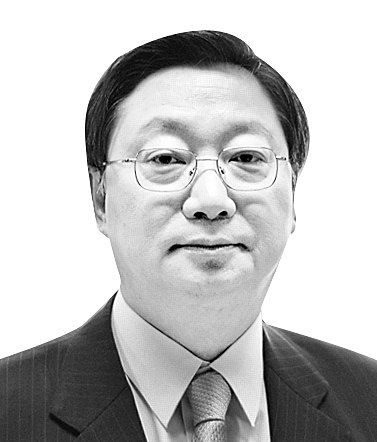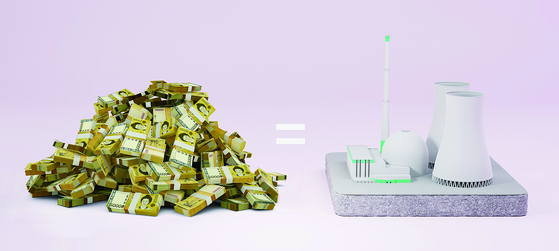A cash cow for a century

The author is an honorary professor of political science and diplomacy at Hanyang University.
The most fruitful meeting President Yoon Suk-yeol had in Madrid, Spain on the sidelines of the NATO Summit in June was with the Czech Republic’s Prime Minister Petr Fiala. Yoon pitched Korean nuclear reactor technology for a $6.6 billion reactor project at the Dukovany Nuclear Power Station. Yoon revived government-level marketing for reactor technology that had been abandoned under the nuclear phase-out policy of his predecessor.
The Czech Republic is inviting bids for a 1.2 million-kilowatt reactor to replace aged reactors in Dukovany, home to four 500-megawatt reactors completed in the late 1980s, whose usefulness will end in 2035. After closely scrutinizing the business model for the reactor and financing means, the Prague government has ruled out Russian and Chinese companies on security grounds. Three companies — Westinghouse, France’s EDF Group, and the Korea Hydro Nuclear Power Corporation (KHNP) — have been invited to bid in March after passing security appraisals.
The preferred bidders — and final winner — will be determined by 2024, and permits for design and construction will be issued in 2029 for the commercial operation of the new reactor in 2036. Korea has price competitiveness against its U.S. and French rivals. Its $20 billion award by the United Arab Emirates and completion of four reactors within the promised timetable are Korea’s biggest selling point.
South Korea has built and safely run 12 pressurized water reactors for 30 years under the two-loop 1000MWe Optimum Power Reactor (OPR) design. The updated APR1400 — an advanced power reactor for 1400MWe — incorporated combustion engineering design. The three newest reactors in Korea are based on APR1400 and three are under construction. The design can be more cost effective than AP1000 technology of Westinghouse and France’s EPR1200. According to a 2020 study of the projected cost of generating electricity by the International Energy Agency (IEA), South Korea showed the average cost of electricity at $53.30 per megawatt per hour, whereas the rate was $71.10 for France and $71.25 for the U.S.
The APR1400 reactors Korea exported to the UAE can produce up to 1,400 megawatts of electricity. They are located in Barakah in the Al Dhafra region of the Emirate of Abu Dhabi, about a two-hour drive from the capital. Although they have a 60-year life span, they can be operational for 80 years through parts replacement. Even if they are switched off, South Korea would be responsible for disposal of high-level radioactive waste. It can make money off the reactors in the UAE for various after-sale services for a century.
During the early digging phase in the UAE, migrant workers from Bangladesh and Pakistan had to endure sizzling desert heat of 55 degrees Celsius (131 degrees Fahrenheit). They took comfort in a canteen at the construction site capable of providing meals for 5,000 at the same time. They were treated with a buffet of food of all types, thanks to the first-hand experience of South Korea having earned foreign currency at desert construction sites in the 1970s.
The Korean reactor industry can expect more work as the Czech Republic plans to build three more reactors. Poland is also pursuing a nuclear reactor project. Under its energy roadmap through 2040, the country envisions six reactors of 600,000KW to 900,000KW in the Baltic Sea coastal site called Lubiatowo-Kopalino. Poland wants to operate the first unit by 2033 and add six more units by 2043.
The KHNP at the forefront of reactor exports has been actively pitching for orders in Eastern Europe and expanding its export base in infrastructure and the nuclear reactor sector.

South Korea is resuming the suspended construction of the Shin Hanul 3 and 4 units. The project of two 1,340MWe APR1400 reactors were included in the fourth energy roadmap in 2008. But it was dropped from the eighth roadmap in December 2017 after President Moon Jae-in, elected in May of that year, announced a phase-out of nuclear reactors. The reactors were again excluded from the ninth energy supply outline in 2020 and formally pronounced dead.
After President Yoon Suk-yeol was elected this year, he endorsed a new energy policy direction to sustain reactors. The two reactors would join the 10th energy outline to be announced in December 2022. Order placements for key equipment will be made in early 2023 and contracts will be signed in July 2023.
To hasten the construction, the project needs a go-ahead permit from the Ministry of Industry, Trade and Energy and a construction license from the Nuclear Safety and Security Commission. These could be advanced if administrative procedures are hastened.
Korea currently runs 24 reactors: five in Gori, two in Saeul, six in Hanvit and six in Hanul. When Shin Hanul 3 and 4 units become operational by 2030, energy sourcing from nuclear reactors would make up around 30 percent of our total and help shield the country against energy crises.
To restore the devastated industrial habitat for reactors, two things are essential. Joining the El Dabaa reactor project in Egypt could place Korea in a better position in its bid for reactor plants in the Czech Republic and Poland and revive the industry at a faster speed. Egypt has consigned Russia’s Atomstroyexport to build four reactors, and KHNP-led Korean builders would supply $2.25 billion worth of equipment for the reactors.
KHNP will build 80 or more turbine buildings and structures for reactors as well as supplying other facility equipment. After working on the order since 2018, the Korean company was chosen as the sole preferred bidder for the second-phase construction last year. It earned score for its successful construction and operation of reactors in UAE of similar business environment.
The other thing needed is restoring Korea’s domestic reactor infrastructure to expedite the revival of the industry. Many parts suppliers have deserted the business after new reactor projects were killed by the last government. The Yoon administration has budgeted over 100 billion won ($73.4 million) to place orders in advance. It has launched a reactor exports committee to systematically spearhead exports.
Japan was a reactor powerhouse with 55 reactors. But since the meltdown from a gigantic earthquake and tsunami in 2011, only nine are in operation, and authorities struggle to prevent blackouts from a shortage of energy.
Since both Korea and Japan lack natural resources, they must generate about 30 percent of power from reactors. The newsroom studio of NHK must keep air-conditioning in a save mode during news time, and public offices must endure heat to save power to underline the pains from shortages of power.
If Korea can export reactors to Czech and Poland, it can fully recover from the disaster of the last five years and win reliable overseas revenues for 100 years. Korea can ascend to the global top in nuclear reactor power like France and Japan in the past if its nuclear industry fuels the economy for power and sustainable growth. Nuclear energy that hardly emits carbon also serves well for its carbon neutrality goal. At the same time, safety of reactors must be placed as top priority.
Translation by the Korea JoongAng Daily staff.










with the Korea JoongAng Daily
To write comments, please log in to one of the accounts.
Standards Board Policy (0/250자)